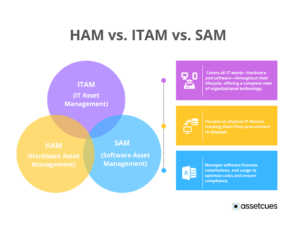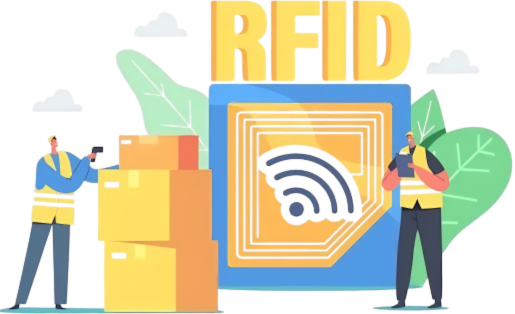Introduction
Hardware asset management (HAM) is the practice of tracking and managing all physical IT assets throughout their lifecycle – from purchase to disposal. Done right, HAM saves money, avoids compliance issues, and strengthens IT security. In large enterprises, keeping tabs on hundreds or thousands of devices can be overwhelming. Lost or unaccounted-for hardware drives up costs and risks, and manual tracking (like spreadsheets) often falls short.
This guide is for IT and asset management professionals in mid-to-large organizations who need clear, actionable advice. Specifically, we cover what HAM is and why it’s important, best practices, and future trends – all in an easy-to-scan format. By the end, you’ll see how effective hardware asset management can cut costs, improve compliance, boost security, and ultimately, how a solution like AssetCues can help put these practices into action.
What is Hardware Asset Management and Why Is It Important?
Hardware Asset Management (HAM) is the end-to-end process of tracking and optimizing a company’s physical IT assets (computers, servers, devices) from procurement through retirement. Effective HAM means you know exactly what hardware you have, who’s using it, and where it is. That visibility helps cut costs, avoid compliance issues, and reduce security risks. In short, HAM gives organizations control over their hardware inventory – a foundation for efficient, secure IT operations.
Preventing waste and saving costs:
Without HAM, organizations often over-purchase or let unused “ghost” assets pile up. Implementing IT asset management for hardware can yield significant savings. Gartner found companies that do ITAM well achieve around 30% cost savings in the first year by eliminating redundant purchases and reusing underutilized hardware. Actively managing hardware also improves budgeting and lifecycle planning. For example, one enterprise discovered about 15% of its devices (worth ~$500,000) were unused or missing. They redeployed those and avoided buying new equipment unnecessarily. These results show HAM’s financial impact.
Compliance and audits:
HAM helps maintain compliance by ensuring accurate records for governance and financial reporting. It supports cybersecurity rules — like SEC mandates to track every IT asset continuously. During audits, updated inventories save time, reduce penalties, and prove compliance quickly. Staying audit-ready prevents risks, unlike the 24% with outdated records Gartner highlighted.
Security and risk reduction:
Untracked devices are security risks — you can’t secure what you don’t know about. HAM provides visibility into all hardware, letting IT enforce encryption, patches, and antivirus. Integrated with security processes, HAM flags rogue devices and blocks network access if needed. It eliminates blind spots, supporting cybersecurity and aligning with what 77% of executives prioritize.
Operational efficiency:
HAM streamlines IT by offering one source of truth for all hardware information. It helps IT act faster — like checking spare laptops or confirming warranty coverage. HAM improves utilization by identifying idle devices that can be redeployed when needed. With lifecycle alerts, IT plans maintenance proactively, reducing downtime and maximizing device value.
HAM vs. ITAM vs. SAM:
IT Asset Management (ITAM) covers all IT assets, both hardware and software. Specifically, Hardware Asset Management (HAM) is the subset focused on physical devices, while Software Asset Management (SAM) focuses on software assets such as licenses, installations, and usage. In practice, HAM and SAM together make up a
complete ITAM program: HAM manages the hardware lifecycle, and SAM manages the software lifecycle. Ultimately, without a solid HAM foundation – knowing your hardware – you can’t effectively manage software or other IT resources.

Why HAM matters now more than ever:
Trends are making HAM more critical than ever. IT budgets are tight, so extending asset life and reu
sing hardware is an easy cost win. Remote and hybrid work have distributed assets outside the office, making tracking devices in home offices a new challenge. The HAM market is booming – projected to reach $93 billion by 2034 – reflecting its growing importance. Companies investing in HAM now will be ahead of the curve, better prepared for audits, cyber threats, and strategic planning. What was once a back-office afterthought is now a must-have discipline for modern IT.
Hardware Asset Management Lifecycle (From Procurement to Disposal)
HAM follows an asset’s journey through your organization. A standard lifecycle ensures no stage is overlooked. Key phases include:
-
Planning & Request:
Route all hardware requests through a formal process (e.g. an IT portal or service desk) so assets are tracked from day one.
-
Procurement/Acquisition:
Record purchase details (vendor, cost, date, warranty, etc.), and integrate procurement systems with HAM so no new asset goes unrecorded.
-
Receiving & Tagging:
When hardware arrives, assign a unique asset ID and tag (barcode/QR or RFID) and enter it into the inventory immediately.
-
Deployment:
When deploying a device, update the system with who has it and where it’s located. Every asset should have an assigned user or location from the start.
-
Usage & Maintenance:
Keep asset information updated during its life. Log maintenance and repairs, and ensure devices remain compliant with security policies.
-
Audits & Updates:
Conduct periodic audits (annual full inventory plus regular spot checks) to reconcile physical assets with your records and fix discrepancies.
-
Retirement & Disposal:
When an asset is end-of-life, mark it retired in the system, securely wipe any data, and dispose of it properly (e.g. recycle with documentation).
-
Refresh or Replacement:
Plan timely refresh cycles (replace devices after X years) using HAM data to budget and replace aging equipment before failures occur.

Say Goodbye to Lost or Untracked Hardware
From durable asset tags to real-time tracking, AssetCues makes IT asset management effortless and accurate.

Say Goodbye to Lost or Untracked Hardware
From durable asset tags to real-time tracking, AssetCues makes IT asset management effortless and accurate.
What Are the Best Practices for Computer Hardware Asset Management?
Effective HAM comes down to consistent processes, collaboration, and smart use of tools. Key best practices include:
-
Keep it simple and practical
Don’t overcomplicate your HAM program. Make processes user-friendly and focus on tracking the most important information. A simple system that people actually use beats a complex one they avoid.
-
Integrate HAM into workflows
Embed asset tracking into daily IT operations. Include hardware steps in onboarding/offboarding, helpdesk, and change management so updates happen naturally. Work with Finance/Security/HR to keep asset info aligned across teams.
-
Use dedicated HAM software
Plan to migrate off spreadsheets to a proper HAM tool as soon as possible. Spreadsheets lack real-time updates, multi-user access, and data integrity checks. A dedicated system supports scanning, integrations, and reporting that make asset management easier and more accurate.
-
Conduct regular audits
Trust but verify your data. Perform a full inventory at least yearly and do interim spot checks. Reconcile what’s in your database with what’s physically out there (and with Finance’s records) to catch issues early and keep data honest.
-
Assign clear ownership
To maintain control, first designate someone (or a team) to own the HAM process and data quality, and then assign responsibility for each asset (usually the user or department using it). As a result, with clear accountability, devices are less likely to disappear.
-
Plan for the full lifecycle
Think ahead about each asset’s lifespan and end-of-life. As a result, set standards for how long different types of hardware are kept, and additionally, have a plan for secure disposal or recycling. This proactive approach, in turn, prevents piles of old, unmanaged equipment and ensures you budget for replacements.
Leveraging Hardware Asset Management Software (Key Features & Considerations)
The right software can greatly enhance your HAM program. When choosing a hardware asset management solution, look for features like:
-
Finance integration:
Integrates IT’s inventory with Finance’s asset register (so your financial and physical records stay in sync).
-
Complete lifecycle tracking:
Covers assets from purchase request through deployment, maintenance, and disposal (with workflows for each stage).
-
Barcode/RFID support:
Supports asset tagging and scanning (printable labels, barcode/QR or RFID input) for quick audits and updates.
-
Transfer & disposal workflows:
Provides processes to log transfers between locations/users and to manage disposals with approvals and documentation.
-
Integrations with IT systems:
Connects with ITSM/CMDB, procurement, and directory/HR systems to eliminate duplicate data entry and keep information updated automatically.
-
Cloud & mobile access:
Offers cloud-based access (so you can use it anywhere) and a mobile app or interface for updating and auditing assets in the field.
-
Reporting & analytics:
Includes reports and dashboards for asset metrics (like assets by location, upcoming replacements) and alerts (e.g. warranty expirations).
-
Security & permissions:
Supports role-based access control (to restrict who can edit/view data) and keeps an audit log of changes. It can also help flag unknown devices by integrating with security tools.
These features form a blueprint for a strong HAM tool. For instance, AssetCues offers all of the above – it’s cloud-based, supports mobile barcode scanning, integrates with ServiceNow and other systems, and covers the full asset lifecycle including financial reconciliation. Ultimately, a tool like this enables many of the best practices we discussed (automation, integration, real-time updates).
Of course, implementation matters too. Plan your rollout: migrate existing data, tag all assets in the new system, set up integrations, and train your team. Maybe pilot the tool in one department first, then expand. Communicate with stakeholders (support teams, Finance, etc.) so everyone is on board. Once your HAM software is up and running, it will reduce manual work and improve consistency – letting you reap the benefits of effective HAM.

Future of Hardware Asset Management: Trends & Next-Gen Practices
HAM is evolving quickly as technology and business needs change. Key trends and next-generation practices include:
AI and predictive analytics:
AI will analyze asset data to predict hardware failures or optimal replacement times, enabling more proactive maintenance.
IoT and real-time tracking:
IoT sensors and smart tags will enable continuous asset tracking, automatically updating inventories and reducing the need for manual audits.
Sustainability focus:
Expect greater emphasis on extending hardware lifecycles and proper e-waste recycling – HAM tools may even track sustainability metrics and ensure retired assets are disposed of responsibly.
Security integration:
HAM will integrate more tightly with cybersecurity (e.g. zero trust), using inventory data to verify and control devices that connect to the network.
Remote and hybrid work:
HAM practices will adapt to manage assets outside the office – from shipping pre-tagged devices to remote staff to having clear processes for retrieving equipment when employees leave.
FAQs: Hardware Asset Management
Q: How often should we conduct hardware asset audits?
A: Perform a full physical inventory at least once per year. In addition, do smaller audits or random spot checks quarterly (or on a rolling schedule) to catch discrepancies early. Regular audits spread out the work and keep your data accurate. Also consider an audit whenever you undergo a major change (like a merger or office move) to verify everything afterward.
Q: Can hardware asset management improve IT security?
A: Absolutely. HAM tracks all hardware, making rogue devices easier to detect and manage. It ensures assets follow policies — for example, verifying encryption or antivirus on laptops. If a device is lost or stolen, HAM helps IT disable or wipe it quickly. During incidents, a current inventory reveals affected devices, owners, and configurations fast.

Interested in seeing how AssetCues works?
Interested in seeing how AssetCues works?

Conclusion & Next Steps
Managing hardware assets may not be glamorous, but it is incredibly impactful. With the right strategies – keeping an accurate inventory, following best practices, and leveraging the proper tools – you can save costs, avoid compliance issues, reduce security risks, and make your IT operations more efficient. A solid HAM foundation also prepares you for future tech innovations, because you’ll have the basics in place as new capabilities like AI or IoT become available.
If you’re looking to elevate your hardware asset management, having the right partner and platform helps. AssetCues – our HAM platform – can put these best practices into action for you. It’s designed to simplify HAM for busy IT teams. Interested in seeing it in action? Feel free to explore our website or schedule a demo to learn how we can help you regain control of your hardware assets, save costs, and ensure compliance.
Here are some ways AssetCues empowers your HAM program:
-
Reconcile IT and finance data:
AssetCues automatically matches your IT asset inventory with your finance records, so both teams stay in sync.
-
Track the full asset lifecycle:
It handles everything from procurement requests to disposal workflows, with checkpoints at each stage to prevent things from slipping through the cracks.
-
Scan assets on the go:
Use AssetCues’ mobile app to scan barcodes during audits or deployments, updating records in real time from anywhere.
-
Simplify transfers and disposals:
The platform provides guided workflows (with audit trails) for moving equipment or retiring old hardware, so nothing “walks away” untracked.
-
Integrate with your IT ecosystem:
AssetCues connects with tools like ServiceNow, Active Directory, and others to provide a single source of truth across your IT operations.
Getting hardware asset management right is much easier with the right tool. Our team built AssetCues with deep ITAM expertise, and we’ve highlighted its features throughout this guide. If you’re ready to step up your HAM game, we’re here to help – from initial setup and asset tagging to long-term success and future-proofing your asset strategy.
With the right approach and tools, hardware asset management can transform from a tedious chore into one of your IT department’s strategic advantages. As a result, you’ll protect your investments, support your users better, and sleep easier knowing there are no surprise gaps in your hardware inventory. So, here’s to optimizing your hardware assets and managing them with confidence!
Thank you for reading. If you have any questions or want to learn more about how AssetCues can fit into your IT environment, don’t hesitate to reach out – we’re here to assist you on your hardware asset management journey.
About Author






